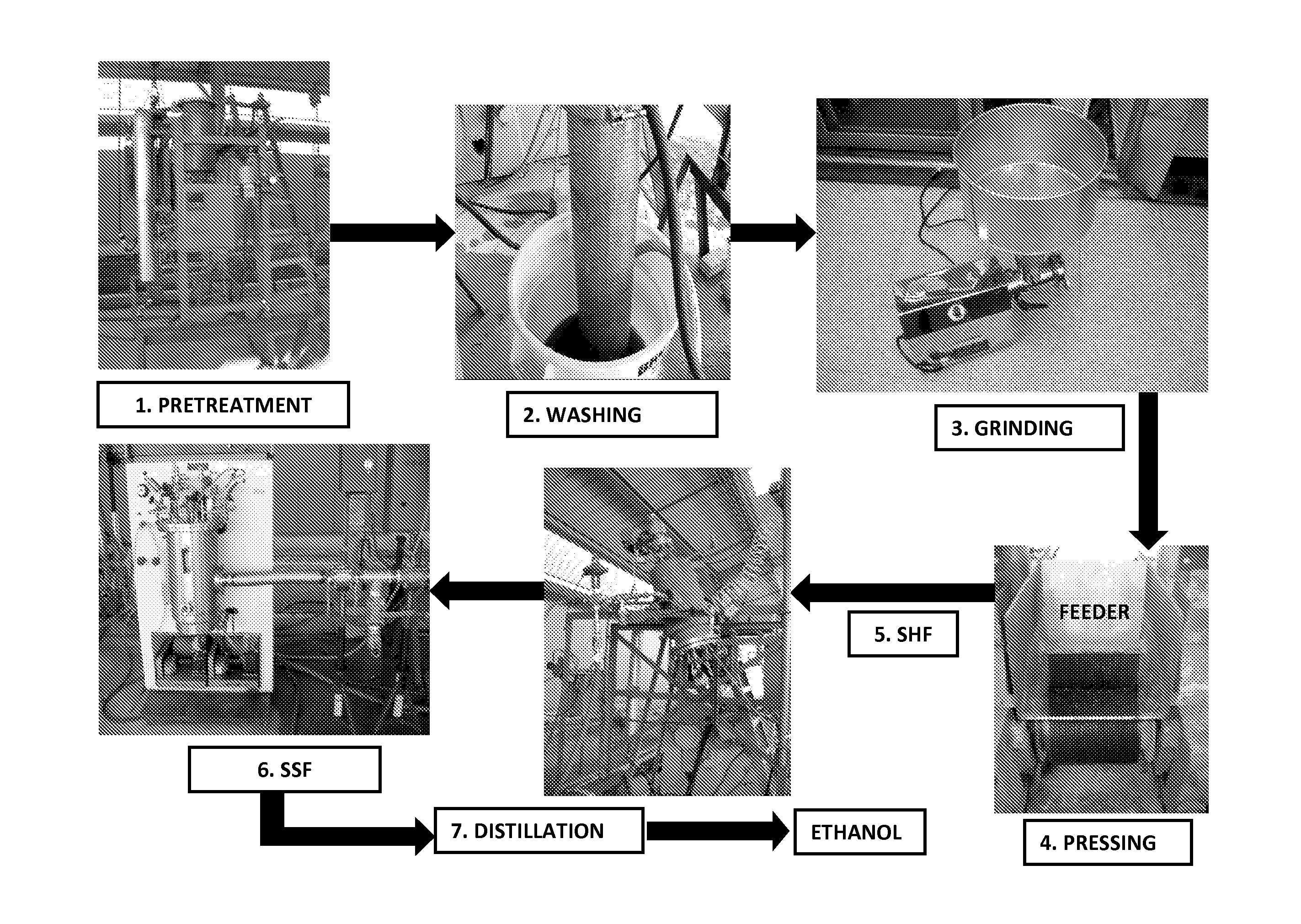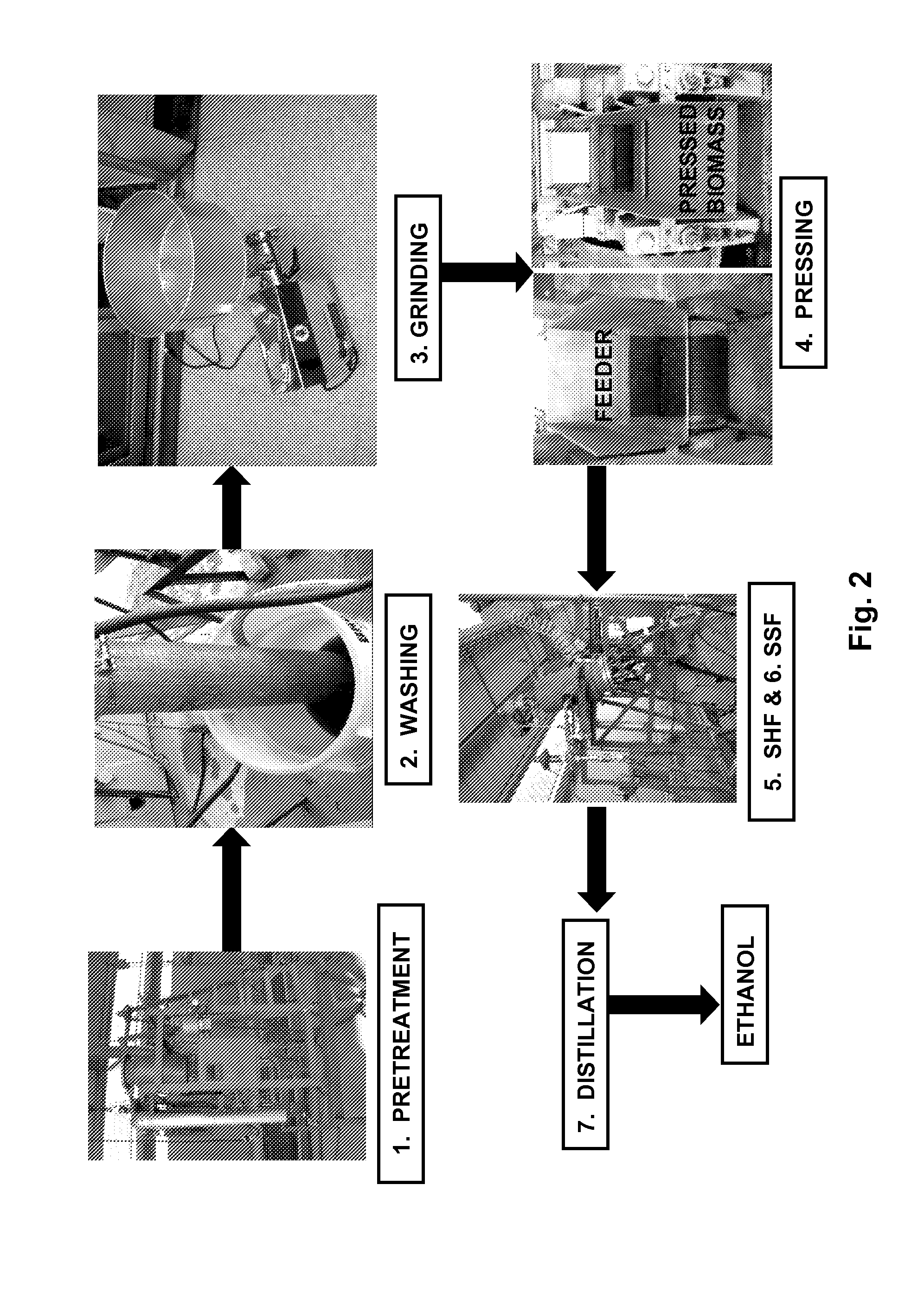Thermochemical Treatment of Lignocellulosics for the Production of Ethanol
a technology of lignocellulosics and ethanol, which is applied in the direction of biofuels, fermentation, microbiology processes, etc., can solve the problems of more chemically hazardous operations and prohibitive costs, and achieves a higher ethanol titer, minimize the carry-over of inhibitors, and optimize the hydrolysis of biomass to sugars
- Summary
- Abstract
- Description
- Claims
- Application Information
AI Technical Summary
Problems solved by technology
Method used
Image
Examples
example 1
Sugarcane Bagasse Composition Analysis
[0036]Biomass composition (cellulose, hemicelluloses and lignin) was calculated before and after pretreatment following National Renewable Energy Laboratory's (NREL) Analytical Laboratory Procedure (LAP 002, 2006) for the determination of carbohydrates and lignin in biomass (Table 1). Composition is calculated in mass percent units, i.e., grams per 100 grams dry biomass. The biomass was dried for 24 h at 110° C. in an oven prior to analyses. Sugars were analyzed (i.e., glucose, cellobiose, mannose, arabinose and xylose) by using an Aminex® HPX-87P, 300 mm×7.8 mm column. Samples were run for 22 min in water at 80° C. All sugar standards were purchased from Sigma Chemical Co. (St. Louis, Mo.).
TABLE 1Composition of untreated, dilute ammonium hydroxide-treated, and water-treatedsugarcane bagasse.Sugarcane BagasseBiomass ConstituentDilute Ammonium(g / 100 g dry biomass)UntreatedWater†HydroxideGlucan (Cellulose)38.460.563.6Xylan (Hemicellulose)24.113.32...
example 2
Determination of Most Effective Solids Loading
[0037]The amount of glucose (g / L) released after enzyme saccharification of biomass at high percent glucan loadings is presented in FIG. 5. SOLKA-FLOC® and Avicel (pure cellulose) were hydrolyzed to 10 g / L, 50-60 g / L, and 80-85 g / L of glucose at 1%, 10% and 30% glucan loadings, respectively. These values represent the maximum amount of glucose that can be obtained under current experimental conditions. Glucose levels for the dilute ammonium-hydroxide treated biomass were 5 g / L, 45 g / L and 50-55 g / L at 0.6%, 5.7% and 17% glucan loadings, respectively. These values represent at least 85% theoretical cellulose conversion. Glucose levels for water-treated biomass were lower.
[0038]In FIG. 5, Lines (1) and (2) provide the maximum limits for saccharification that are given by the pure cellulose standards (Avicel and SOLKA-FLOC®). It is not possible to obtain more glucose out of a pretreated biomass sample than that obtained when using pure cell...
example 3
Pretreatment, Washing, Grinding and Pressing
[0039]Pretreatment. Biomass, water and ammonium hydroxide are used in mass proportions of about 1:8:0.14. The sugarcane bagasse was used without drying and contained about 24% moisture. Water was added to the biomass in sufficient quantity to prepare a slurry. The stock ammonium hydroxide solution was weighed into a pressurized stainless steel container and mixed with water. The ammonium hydroxide and water mixture in the pressurized stainless steel container was then emptied into the reactor with the biomass by pressurizing the container with air. The reactor was a cylindrical, high-pressure vessel from Ohio Valley Steel (Ohio) built with INCONEL® alloy, with a volume of 22.1 liters (at 22° C.), and equipped with a jacket for heating and cooling. The reactor had pressure and temperature gauges for monitoring and controlling operating conditions. Top and bottom ports were fitted with quick-disconnect ports for the washing step. The mixture...
PUM
| Property | Measurement | Unit |
|---|---|---|
| temperature | aaaaa | aaaaa |
| temperature | aaaaa | aaaaa |
| temperature | aaaaa | aaaaa |
Abstract
Description
Claims
Application Information
 Login to View More
Login to View More - R&D
- Intellectual Property
- Life Sciences
- Materials
- Tech Scout
- Unparalleled Data Quality
- Higher Quality Content
- 60% Fewer Hallucinations
Browse by: Latest US Patents, China's latest patents, Technical Efficacy Thesaurus, Application Domain, Technology Topic, Popular Technical Reports.
© 2025 PatSnap. All rights reserved.Legal|Privacy policy|Modern Slavery Act Transparency Statement|Sitemap|About US| Contact US: help@patsnap.com



